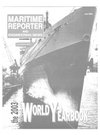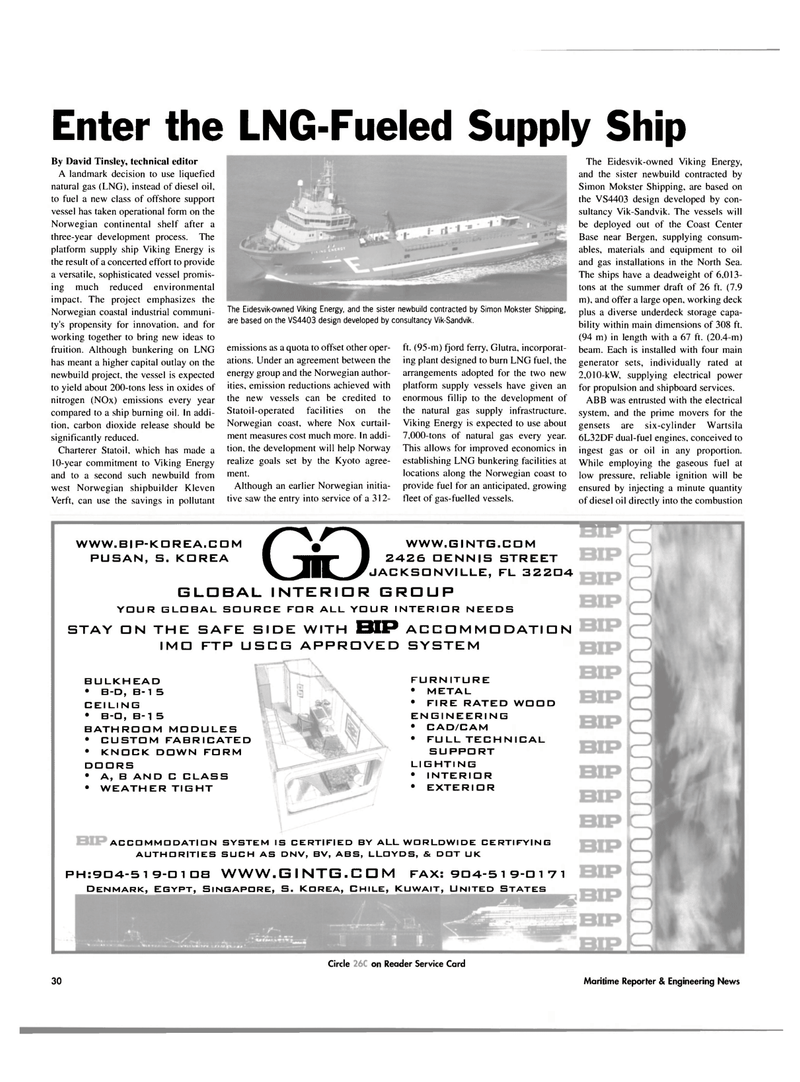
Page 30: of Maritime Reporter Magazine (June 2003)
Read this page in Pdf, Flash or Html5 edition of June 2003 Maritime Reporter Magazine
Enter the LNG-Fueled Supply Ship
By David Tinsley, technical editor
A landmark decision to use liquefied natural gas (LNG), instead of diesel oil, to fuel a new class of offshore support vessel has taken operational form on the
Norwegian continental shelf after a three-year development process. The platform supply ship Viking Energy is the result of a concerted effort to provide a versatile, sophisticated vessel promis- ing much reduced environmental impact. The project emphasizes the
Norwegian coastal industrial communi- ty's propensity for innovation, and for working together to bring new ideas to fruition. Although bunkering on LNG has meant a higher capital outlay on the newbuild project, the vessel is expected to yield about 200-tons less in oxides of nitrogen (NOx) emissions every year compared to a ship burning oil. In addi- tion, carbon dioxide release should be significantly reduced.
Charterer Statoil, which has made a 10-year commitment to Viking Energy and to a second such newbuild from west Norwegian shipbuilder Kleven
Verft, can use the savings in pollutant
The Eidesvik-owned Viking Energy, and the sister newbuild contracted by Simon Mokster Shipping, are based on the VS4403 design developed by consultancy Vik-Sandvik. emissions as a quota to offset other oper- ations. Under an agreement between the energy group and the Norwegian author- ities, emission reductions achieved with the new vessels can be credited to
Statoil-operated facilities on the
Norwegian coast, where Nox curtail- ment measures cost much more. In addi- tion, the development will help Norway realize goals set by the Kyoto agree- ment.
Although an earlier Norwegian initia- tive saw the entry into service of a 312- ft. (95-m) fjord ferry, Glutra, incorporat- ing plant designed to burn LNG fuel, the arrangements adopted for the two new platform supply vessels have given an enormous fillip to the development of the natural gas supply infrastructure.
Viking Energy is expected to use about 7,000-tons of natural gas every year.
This allows for improved economics in establishing LNG bunkering facilities at locations along the Norwegian coast to provide fuel for an anticipated, growing fleet of gas-fuelled vessels.
WWW.BIP-KDREA.CDM
PUSAN, S. KOREA GO
WWW.GINTG.CDM 2426 DENNIS STREET
JACKSONVILLE, FL 322D4
GLOBAL INTERIOR GROUP
YOUR GLOBAL SOURCE FOR ALL YOUR INTERIOR NEEDS
STAY ON THE SAFE SIDE WITH BIP A C C O M M O D ATI D N
IMD FTP USCG APPROVED SYSTEM
BULKHEAD • B-D, B- 1 5
CEILING • B-O, B- 1 5
BATHROOM MODULES • CUSTOM FABRICATED • KNOCK DOWN FORM
DOORS • A, B AND C CLASS • WEATHER TIGHT
FURNITURE • METAL • FIRE RATED WOOD
ENGINEERING • CAD/CAM • FULL TECHNICAL
SUPPORT
LIGHTING • INTERIOR • EXTERIOR
ACCOMMODATION SYSTEM IS CERTIFIED BY ALL WORLDWIDE CERTIFYING
AUTHORITIES SUCH AS DNV, BV, ABS, LLOYDS, & DOT UK
PH:9D4-5 1 9-D 1 DS WWW.GINTG.COM FAX: 9D4-519-D171
DENMARK, EGYPT, SINGAPORE, S. KOREA, CHILE, KUWAIT, UNITED STATES
The Eidesvik-owned Viking Energy, and the sister newbuild contracted by
Simon Mokster Shipping, are based on the VS4403 design developed by con- sultancy Vik-Sandvik. The vessels will be deployed out of the Coast Center
Base near Bergen, supplying consum- ables, materials and equipment to oil and gas installations in the North Sea.
The ships have a deadweight of 6,013- tons at the summer draft of 26 ft. (7.9 m), and offer a large open, working deck plus a diverse underdeck storage capa- bility within main dimensions of 308 ft. (94 m) in length with a 67 ft. (20.4-m) beam. Each is installed with four main generator sets, individually rated at 2,010-kW, supplying electrical power for propulsion and shipboard services.
ABB was entrusted with the electrical system, and the prime movers for the gensets are six-cylinder Wartsila 6L32DF dual-fuel engines, conceived to ingest gas or oil in any proportion.
While employing the gaseous fuel at low pressure, reliable ignition will be ensured by injecting a minute quantity of diesel oil directly into the combustion
Circle 348 on Reader Service Card 30 Maritime Reporter & Engineering News

 29
29

 31
31
